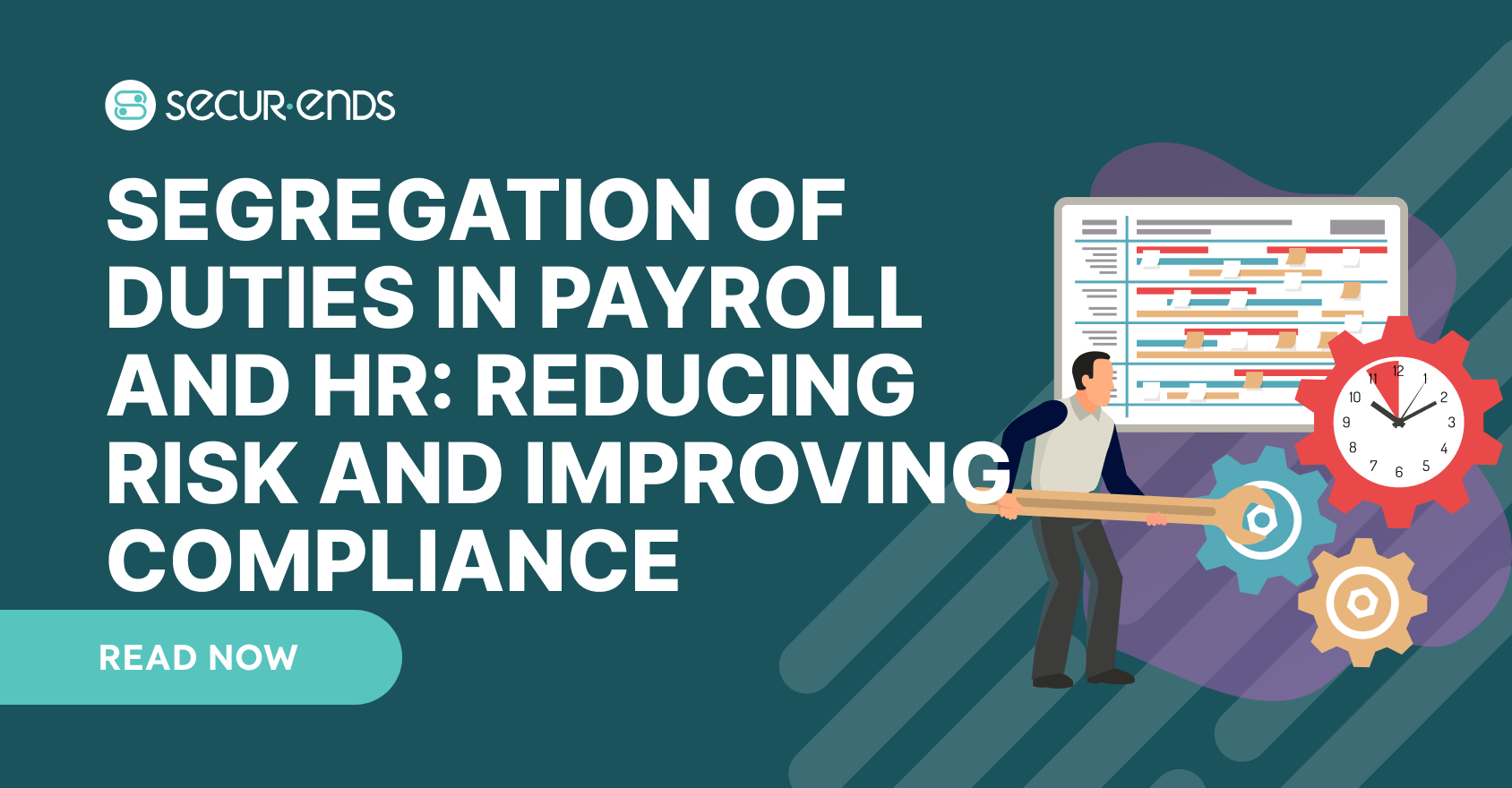Segregation of Duties in Payroll and HR: Reducing Risk and Improving Compliance
Segregation of Duties in Payroll and HR: Reducing Risk and Improving Compliance

Introduction
Payroll and HR deal with sensitive money and private data. That makes them high-risk for fraud and mistakes. One person adding employees, calculating pay, approving payments, and distributing funds? Too much control, no checks.
That’s where segregation of duties payroll controls matter. Responsibilities get split across HR, payroll, and finance. Each step is checked by someone else. Errors surface. Fraud slows down. Auditors see evidence that controls exist and work.
SoD in payroll and HR isn’t red tape—it’s protection.
What Does Segregation of Duties in Payroll Mean?
In segregation of duties payroll practice, key tasks are split: employee setup, pay calculation, payment approval, and reconciliation.
Without SoD, risks stack up. Ghost employees get added. Overpayments pass through. Benefits are abused. One person running the cycle unchecked is an open door for fraud.
What is an example of segregation of duties in payroll?
One clerk adds new hires. Payroll calculates pay. Finance authorizes payments. That chain is a clean payroll segregation of duties example—blocking ghost employees and fraudulent payouts before they hit accounts.
Why Segregation of Duties Payroll Controls Are Critical
Preventing Payroll Fraud
Payroll fraud is common. An HR clerk once added fake employees and issued paychecks to them. Nobody checked for months. With segregation of duties in payroll, HR adds staff, payroll runs pay, finance approves funds. Fraud dies at the first wall.
Ensuring Accurate Employee Compensation
Errors cost money. If one role calculates and approves, mistakes slip through. Split those tasks and pay accuracy rises. Employees get the right money, at the right time, with fewer disputes.
Reducing Insider Threats
Payroll insiders know the loopholes best. That’s why segregation of duties payroll rules limit their power. One person can’t both process and distribute. Oversight forces accountability.
Why is segregation of duties important in payroll?
Because it keeps payroll clean—blocking fraud, reducing miscalculations, and satisfying compliance checks. Without it, risk wins.
Payroll Process Segregation of Duties Examples
Payroll workflows are vulnerable when one role handles too much. These segregation of duties payroll examples show how splitting tasks lowers risk:
Employee Setup vs. Payroll Processing
HR adds employees. Payroll processes pay. If HR also runs payroll, ghost workers slip in. A company once paid thousands to fake staff created by a single HR admin.
Payroll Calculation vs. Payment Authorization
Payroll calculates net pay. Finance authorizes payments. If one role does both, inflated checks go unnoticed. With payroll segregation of duties, payouts get an extra layer of oversight.
Payroll Reconciliation vs. Distribution
Payroll reconciles numbers. Finance distributes funds. Without this split, reconciliation is skipped. Errors and fraud hide. Clear segregation of duties in payroll ensures both review and independent disbursement.
HR and Payroll Segregation of Duties Overlaps
Payroll and HR overlap naturally. But overlap without checks is dangerous. If one HR admin sets salaries, adds staff, and approves pay, fraud is almost certain.
Who should approve payroll in segregation of duties?
Approval should sit outside payroll processing. Finance or senior management should sign off. This ensures payroll staff can’t self-approve their work. It’s the control line that segregation of duties payroll rules are built on.
Segregation of Duties in Payroll Compliance Requirements
SOX, HIPAA, GDPR—all require proof that payroll is controlled. Regulators expect SoD across employee data, salary approvals, and fund disbursements.
What controls are needed for payroll segregation of duties?
Core ones include: HR adds staff, payroll calculates, finance approves, and reconciliation is independent. Dual approval for large payouts. Audit logs of who did what. These are the controls that make segregation of duties payroll practical, not just policy.
Common Payroll Segregation of Duties Conflicts
Conflicts pop up when:
- Payroll managers add employees and approve payments.
- HR staff issue checks directly.
- No reconciliation is done outside payroll.
Case study: A city government found years of fraud when one clerk created ghost workers and paid them. Strong payroll segregation of duties controls would have stopped it before it spread.
Payroll Segregation of Duties Matrix
A matrix makes conflicts easy to spot.
| Role | Employee Setup | Payroll Calculation | Payment Authorization | Reconciliation |
| HR Admin | ✅ | ❌ | ❌ | ❌ |
| Payroll Clerk | ❌ | ✅ | ❌ | ❌ |
| Finance Manager | ❌ | ❌ | ✅ | ❌ |
| Controller | ❌ | ❌ | ❌ | ✅ |
This simple chart proves segregation of duties in payroll to auditors.
Automating Payroll SoD Controls with SecurEnds
Manual checks lag. Spreadsheets miss conflicts. SecurEnds automates segregation of duties payroll controls:
- Access reviews: Conflicts flagged before payday.
- RBAC enforcement: Roles locked to what’s necessary.
- Continuous monitoring: Logs show who did what, always audit-ready.
Automation turns payroll segregation of duties from policy into daily practice.
Conclusion: Strengthening Payroll and HR Integrity with SoD
Payroll and HR carry big fraud risk. Segregation of duties payroll controls close the gaps—blocking ghost employees, inflated checks, and insider fraud.
Split roles. Require approvals. Reconcile independently. Compliance improves. Fraud gets harder. Trust builds.
With SecurEnds, payroll segregation of duties isn’t a checklist—it’s automated. Conflicts are flagged in real time, audit logs stay ready, and payroll remains secure.
FAQs on Segregation of Duties in Payroll
What is segregation of duties in payroll processing?
It means splitting payroll into steps—setup, calculation, authorization, reconciliation—so no single person runs the cycle end-to-end.
How do small businesses implement SoD?
Rotate duties. Get supervisors to sign off. Use external accountants for reviews. Even small teams can enforce segregation of duties in payroll with creativity.
Can outsourcing help?
Yes. Outsourced payroll providers enforce SoD by design. They separate data entry, calculation, and payment—giving small firms built-in safeguards.
What happens if SoD isn’t enforced?
Ghost employees, fake payouts, compliance violations, and lost trust. Auditors flag it, regulators fine it, and the business pays the price.